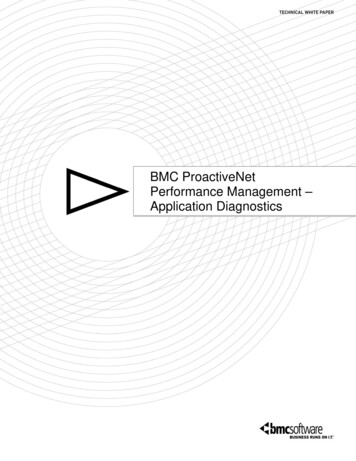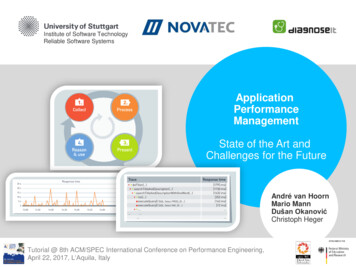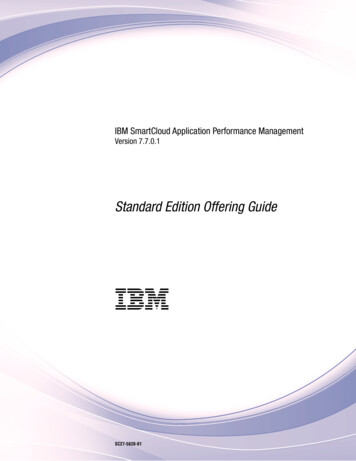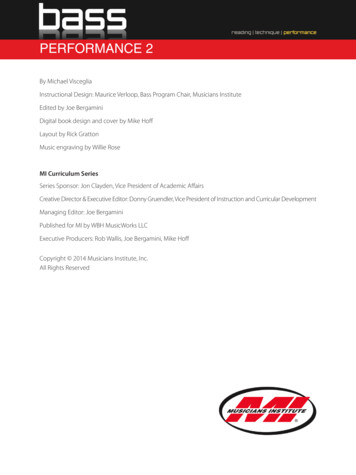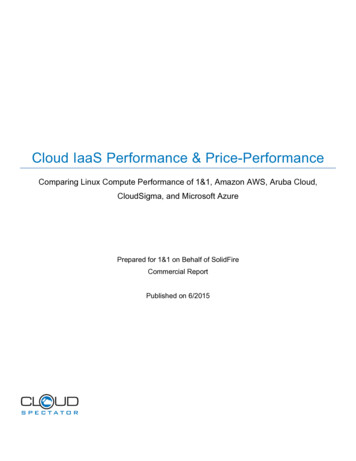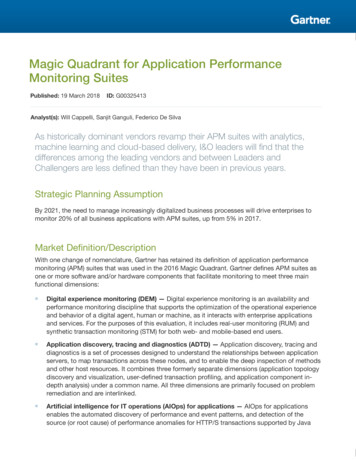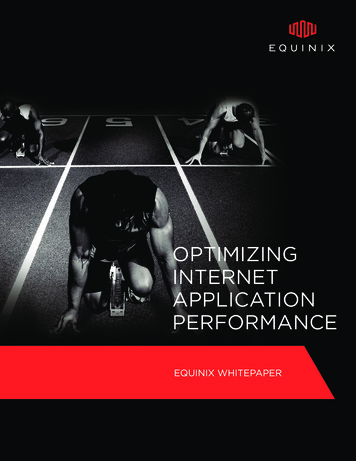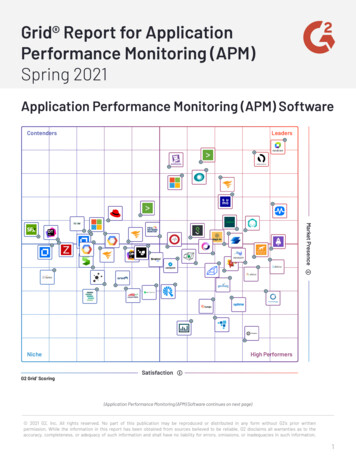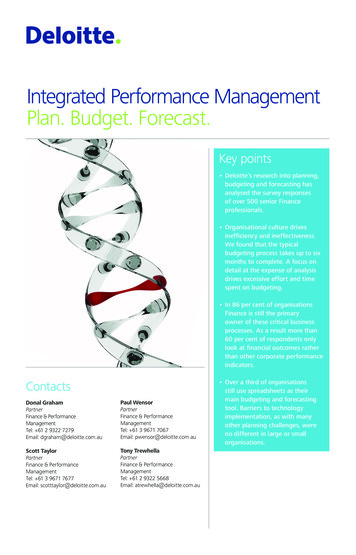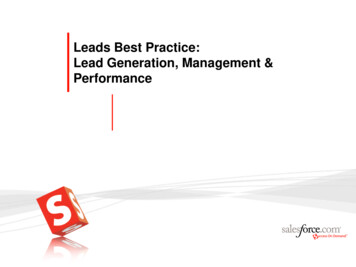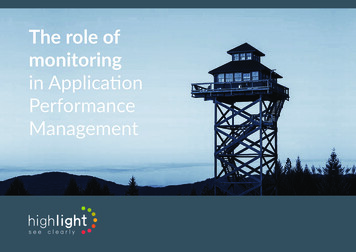
Transcription
The role ofmonitoringin ApplicationPerformanceManagement
Table of ContentsEvery minute an application is slow or down it hurts your business.3What is the cause?.4The performance blame game.5Cultivating trusted relationships.6The rise of Application Performance Monitoring.7Who needs monitoring?.85 key features to look for when choosing an ApplicationPerformance Monitoring solution.9Conclusion.11About Highlight.12 Highlight (SLM) Ltd2
Every minute an application is slow or downit hurts your businessOver the years, applications have become increasingly complex to manage.With the adoption of Service-Orientated architecture, the Cloud, Hybrid IT and Big Data,applications are now more distributed than ever with hundreds upon thousands beingmanaged by third party services, not to forget the complications around shadow IT.The migration of applications into the Cloud has increased the need for tools to managenetwork and application performance for both the Managed Service Provider (MSP) andCorporate Customer across every vertical market sector. Most importantly, the availabilityand overall user experience of applications has become a focal point for businesses.Without the joint visibility of network and application, the close monitoring andmanagement of business-critical applications performance cannot be achieved effectively,leaving end users often unaware of what is causing poor performance of their applications.The Role of Monitoring in Application Performance Management3
What is the cause?Is it poorly performing network infrastructure? Perhaps it is non-critical andunauthorised applications consuming the network or server resources. Or is thereinsufficient network capacity to handle the valid business application traffic?How are organisations with zero to little network and application performance visibilityand management supposed to improve or correct this business impacting conditions?The truth is that without visibility, they can’t.“ one in four organisations have noidea which “unofficial” applications arerunning on their IT infrastructure.”It is therefore vital that IT staff have the ability to see clearly and determine the bestaction to resolve growing performance issues before it has a critical effect on theentire business operation.Source: Cloud Security Alliance (CSA) Jan 2015The Role of Monitoring in Application Performance Management4
The performance blame gameMSPs ultimately have common goals; delivering effective services, driving out costsfrom their business, offering prices to their corporate customers to suit businessrequirements and differentiating their service experience from competitors.When it comes down to effective cost control, performance monitoring is key.Being unable to actively monitor customers’ applications and infrastructureperformance in relationship with one another leaves neither MSP nor customers in aposition to understand where problems are arising.All too often MSPs can’t see customers application events that impact the networkadversely and similarly, corporate enterprises are unable to see when and how theseevents are affecting their infrastructure. This condition leads to customers believingtheir provider’s network is of poor quality and the service provider has no evidenceto dispute this claim.The divide is between application and infrastructure performance events, combinedwith a lack of transparency of both components within the IT landscape. Gartnerviews the two as being distinct: I nfrastructure teams normally operate in different organisations which meansperformance is monitored in isolation. Teams then face the blame game whenissues arise as each team comes to the table to discuss the root cause of thefault. SPs and their customers are often left in the dark as a result, especially ifMtheir application performance management tool seems to be showing noissues within the applications themselves. As a result, it is assumed that thereis fault with the infrastructure, when in fact one has to be able to see clearlyboth components of the IT landscape to clearly identify the cause. Highlight (SLM) LtdMSPs and customers can no longer afford to not have completevisibility of network infrastructure events and applicationperformance in one view. More than ever, it’s extremely importantthat tools have full capability to show the source of arising issues.A synergy between application and infrastructure performance management isconverging as more MSPs realise the importance of monitoring the two in correlationto provide greater transparency for their customers and in turn increase productivityand effective management.5
Cultivating trusted relationshipsIn a service-driven environment where competition is fierce, it’s important to buildand maintain trusted relationships. These are easily destroyed if customers aren’treceiving the highest quality of service experience and visibility.MSPs need to deliver joined-up application and infrastructure performancemanagement ensuring enterprises can focus on their most important businessobjectives to save time, resources and money, in turn avoiding the blame game.The Role of Monitoring in Application Performance Management6
The rise of Application Performance MonitoringThe Application Performance Management (APM) industry is advancing rapidlyto support these growing needs, with expectations to reach 5.6 billion by 2020according to a forecast from Enterprise Software Markets Worldwide 2014 – 2021.APM first started appearing in the late 90s with solutions such as Precise, Wily andMercury Interactive. Towards the mid-2000s APM tools took a more consolidatedapproach whereby they were acquired by larger vendors who integrated them intolarger suites, often unsuccessfully.Around 2009, the more “modern” APM tools emerged, aimed at the new breed ofdistributed systems running in virtualized, cloud environments. Major vendors of APMtoday include tools by New Relic, Dynatrace and App Dynamics (now owned by Cisco).Alongside Application Performance Management, the term Application PerformanceMonitoring appeared. Whilst the Management industry holds a significant place inthe market, Monitoring is sometimes dismissed – an easy mistake since there’s onlya thin line between the two. Monitoring refers to the collection of performance datawhilst Management is a much broader term. Highlight (SLM) Ltd7
Who needs monitoring?MSPs are amongst the key players in the market requiring Application PerformanceMonitoring. To allow for effective customer engagement and quick issue resolution,there must be a tool in place that allows the MSP to monitor their corporatecustomers’ requirements.Lack of performance monitoring can lead to costly downtime affecting budgets,operations and infrastructure, as well as disabling employees from carrying out their job.Service Providers and their corporate customers need to be speaking the samelanguage, using a shared tool with simple graphical information that can beunderstood by business users and technical teams alike, allowing them to see clearlythe quality and performance of key applications.Decision makers don’t have time to drill down to the nitty-gritty details ofapplications. An interface which pushes this information to the surface allows usersto view application crisis building in real-time. When problems arise, a customer canpick up the phone to their service provider and have the right discussions at the righttime leading to proactive issue resolution.It can’t be stressed enough; not monitoring the performance of criticalapplications can be a costly mistake. If sluggish or failed applicationscan be prevented by good visibility, then it’s a win-win situation for bothservice provider and customer, bringing them together on a relationshipbuilt through transparency.The Role of Monitoring in Application Performance Management8
5 key features to look for when choosing anApplication Performance Monitoring solutionHere are some key features to help MSPs to determine the best tool for the job:Single shared consolidated viewAn application performance monitoring tool needs to work alongside other tools toensure the smooth functioning of business operations. This removes the time wastedlogging into different tools and correlating data which can leave a tainted userexperience, lack of consistency and human error.An authentic, multi-tenant, multi-tier tool consolidating all operations into oneis a must to monitor all services (including Application Performance) of all yourcustomers. This ensures that valuable time and context is not lost by unnecessaryswitching between tools.It’s critical that this view is shared between MSP and customers, creating executivelevel transparency and establishing factual trust.Graphical displayYou want to be able to see the most relevant information pushed to the surface,at a glance. Having an interface with a “no clutter, all fact” design ethos means thatinformation is presented with a focus on business-critical elements and you caneasily drill down to the detail of applications.Knowing where, when and what application traffic is flowing through your networkhelps control costs, as well as spotting the appearance of unauthorised applications.Why restrict the list of people who can benefit from this insight? Your corporatecustomers’ sales and service management personnel don’t want to rely onengineering and operations management to translate information into somethingmeaningful every time. Information and time is crucial to smooth running, so it’simportant that this isn’t hiding behind intimidating network engineering tools. Highlight (SLM) LtdUsers of all technical levels need to understand and get value from the information.It’s amazing how often MSPs say “Yes, we have tools in place to do this” but thosetools are only used by engineers - never by key stakeholders like Sales AccountManagers, Service Managers, or Retention teams, where there’s huge value to begained from seeing what their customers see.Users love simplicity. Using a universal colour system such as red-amber-green toshow stability, load and health of network and application performance also meansthat anyone can understand what’s being displayed to them.9
Issue detectionIf applications become slow this likely points to a performance problem. Ratherthan letting applications get to this stage, use a tool which shows crises building inreal-time before they become a problem. This reduces inefficiencies and preventsbusiness functions coming to halt.AlertingA tool which provides intelligent custom alerts and reduces false alarms to enableproactive issue resolution is another priority. The ability to be alerted withoutthe need for continuously logging into your tool means you can focus on what’simportant; you can trust that you’ll be alerted when something is wrong with yourapplication’s health.Breakdowns, trends and reportingFor those who are more technically minded or just curious about investigatingapplication performance issues, it’s important that you can drill down intoinformation and detect trends and patterns. Having a real-time and retrospectiveview that allows you to look back at the past week, month or even year will enableyou to correlate application events and provide explanations. This aids in capacityplanning and future proofing your IT landscape.Having an alerting and reporting method which is designed for speed and simplicity,enables you to draw on raw and pre-summarised data. This means you’re saving timeand can hold the right discussions at any time with your customers.The Role of Monitoring in Application Performance Management10
ConclusionMonitoring application performance is not the end goal it’s the quality of service delivered and received by the customer.MSPs and professionals from IT and commercial business teams need visibility andaccess to information on applications being used at any given time and location insight which can pinpoint performance and availability issues.What’s more, managers require this information in an easy to understand, tangible,graphical format which is available in real-time; enabling decision makers of botha technical and non-technical nature to identify the causes of business-criticalapplication issues and determine the corrective action in partnership.Ultimately, this requirement is driven by the business need to be effective andensure a positive user experience. Nothing irks customers more than slow responsetimes or when business-critical applications are down. Monitoring performance ofapplications and infrastructure is not the end goal, the focus must be on the qualityof service both delivered and received by the customer. Highlight (SLM) Ltd11
About HighlightHighlight is a cloud-based monitoring service enabling Sales, Service Managers andOperations Managers to see clearly, showing all managed services through a singlepane of glass.It provides accurate, impartial evidence of applications and network serviceperformance across all locations, creating trusted advisor relationships, betweenService Providers and their Corporate Customers.Highlight is designed for non-technical and technical professionals who need acommercial/business management view of IT infrastructure and application performance.Our vision is to be the best sales and service management tool for Network andManaged Services providers which enables trusted advisor partnerships with theircorporate customers.Share on social media:Cover: Summit Prairie Lookout Tower in Oregon, USAPg 11: Swedish traffic jam in 196712Get in touch 44 (0) 1483 209970Highlight - See ClearlyIf you are a service provider and want to know more on howHighlight can help you with Application Performance Monitoringor other features, please get in touch:sales@highlight.net@Highlight nethighlight.netHighlight Highlight (SLM) Ltd
The rise of Application Performance Monitoring The Application Performance Management (APM) industry is advancing rapidly to support these growing needs, with expectations to reach 5.6 billion by 2020 according to a forecas
